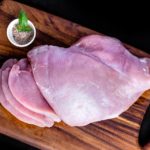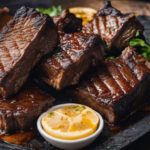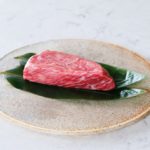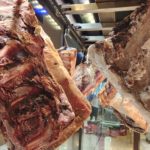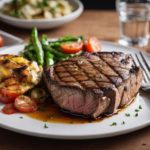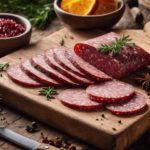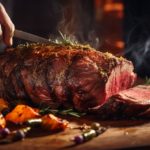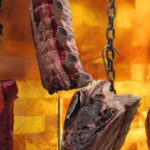Are you a steak lover always on the hunt for juicy, tender cuts? It’s fascinating to know that beef aging dates back to the 1950s and is more than just an ordinary process of crafting luxurious flavors into your favorite cuts.
Our blog today delves deep into exploring different cuts of dry aged beef – their uniqueness, benefits, selection tips, and how they underscore gourmet gastronomy. Ready for a mouthwatering read?.
Key Takeaways
- Dry aging is a process that makes meat taste better and more tender by hanging it in a cool room or on racks for several days or weeks.
- Choosing the right cuts of beef is important for dry aging, with factors such as marbling, thickness, and natural juiciness being key considerations.
- Different cuts of dry aged beef have their own unique flavors and characteristics, with ribeye, tenderloin, striploin, sirloin, and T-bone steak being popular choices.
- Various cooking methods can be paired with different cuts of dry – aged beef to bring out their delicious flavors and create an exceptional dining experience.
The Basics of Dry Aging Beef
Dry aging is a process in which beef is aged for an extended period of time to enhance its flavor and tenderness.
What is dry aging?
Dry aging is a special way to make meat taste better. It takes time and care. Butchers hang up the beef in a cool room or put it on racks. They leave it there for several days or even weeks.
The air in the room helps change the beef’s taste and feel. Dry aging makes the meat more tender, which means it is softer and easier to chew. The meat also gets a rich, deep flavor that many people love.
This process was found out in the 1950s and has been used since then to give us some of our favorite steaks!
How is dry aging done?
Dry aging is done by hanging beef carcasses or placing unpackaged primal cuts in a refrigerated room. Here’s how it’s done:
- Beef carcasses or primal cuts are carefully stored in a temperature and humidity – controlled environment.
- The meat is left to age for a certain period, typically ranging from several days to several weeks.
- During this time, the natural enzymes in the meat break down proteins, resulting in increased tenderness.
- The aging process also allows for the evaporation of moisture, intensifying the flavor of the meat.
- Regular monitoring of temperature and humidity levels is crucial to ensure optimal conditions for dry aging.
- After the desired period of aging, the meat is carefully trimmed to remove any superficially dried or hardened parts.
- The remaining dry – aged beef is then ready to be cooked and enjoyed for its rich, complex flavors.
The benefits of dry aging
Dry aging beef has many benefits that meat lovers can enjoy. Firstly, the dry aging process allows natural enzymes to break down proteins in the meat, resulting in a more tender and juicy steak.
This makes each bite incredibly flavorful and satisfying. Additionally, dry-aged beef develops a unique and complex taste due to the concentration of flavors during the aging process.
The high-fat content and marbling of certain cuts, like ribeye or striploin, further enhance the luxurious experience of enjoying dry-aged beef. While this method requires additional time and resources, the cost is well worth it for those seeking an exceptional dining experience.
The Best Cuts for Dry Aged Beef
Choosing the right cuts is crucial when it comes to dry aging beef, as certain cuts lend themselves better to this process.
Choosing the right cuts
Choosing the right cuts of beef is important when it comes to dry aging. Here are some factors to consider:
- Marbling: Look for cuts with a good amount of marbling, as this fat will help enhance the flavor and tenderness during the aging process.
- Thickness: Thicker cuts are more ideal for dry aging, as they provide a larger area for the flavors to develop and penetrate the meat.
- Juicy steak: Cuts that are naturally juicy and flavorful, like ribeye or striploin, are great choices for dry aging.
- Tenderloin: The tenderloin is another popular cut for dry aging because of its tenderness and delicate flavor.
- Sirloin: Sirloin is a versatile cut that can be dry aged to bring out its rich flavor and tenderness.
- T-bone steak: T-bone steaks, with their combination of tenderloin and striploin, can also be dry aged to create a luxurious eating experience.
Cuts that are ideal for dry aging
Dry aging is a process that enhances the flavor and tenderness of beef, and certain cuts are particularly well-suited for this method. One popular choice is the ribeye steak, which has a high-fat content and marbling, resulting in a juicy and flavorful steak.
Another great option is the tenderloin, also known as filet mignon, which is naturally tender and benefits from the dry aging process. Striploin and sirloin cuts are also ideal for dry aging because they have good marbling and offer a balance of tenderness and rich flavors.
T-bone steak, with its combination of striploin and tenderloin sections, can also be an excellent choice for dry aging. These cuts provide meat lovers with luxurious flavors that make every bite truly indulgent.
Factors to consider when selecting cuts
When choosing cuts for dry aging, there are a few important factors to consider:
- Marbling: Look for cuts with good marbling, which refers to the small flecks of fat within the muscle. This fat adds flavor and moisture to the meat during the aging process.
- Thickness: Thicker cuts are better suited for dry aging because they allow for more even distribution of flavors and tenderness throughout the meat.
- Juiciness: Choose cuts that are known for being naturally juicy. This will help ensure that the meat remains moist and flavorful after the aging process.
- Tenderization potential: Some cuts naturally have more tender meat than others. Consider selecting cuts like ribeye or tenderloin, which tend to be more tender even without dry aging.
- Flavor preference: Different cuts offer different flavor profiles, so think about your personal taste preferences when selecting a cut for dry aging.
Exploring the Flavor Profiles of Different Cuts
Discover the mouthwatering flavors of various dry aged beef cuts and how the aging process brings out their unique characteristics. Dive in to explore which cuts pair best with different cooking methods, leaving you craving more.
Tasting notes and characteristics of various cuts
Dry-aged beef offers a variety of flavors and characteristics depending on the cut. Ribeye, known for its marbling and rich flavor, becomes even more tender and succulent during the dry aging process.
Tenderloin, on the other hand, is already incredibly tender but gains a unique buttery texture when aged. Striploin delivers a balance between tenderness and robust beefy flavor, while sirloin offers a bold taste with some chewiness.
T-bone steak combines both tenderloin and striploin cuts, providing a mix of flavors in one meaty dish. Each cut has its own distinct qualities that elevate the overall dining experience for meat enthusiasts.
How the aging process enhances flavor
Dry aging is a process that can enhance the flavor of beef. During dry aging, enzymes in the meat break down proteins, making it more tender and flavorful. This results in a rich and intense taste that regular beef doesn’t have.
The longer the meat ages, the more pronounced these flavors become. Chefs and food scientists love dry-aged beef because of its luxurious and complex flavors. It’s definitely worth trying if you’re a meat lover who wants a tasty and tender steak experience.
Just be aware that dry-aged beef is usually more expensive than regular beef due to the extra time and resources required for the aging process.
Pairing cuts with different cooking methods
Dry-aged beef can be cooked in various ways to bring out its delicious flavors. Here are some ideas to help you pair different cuts of dry-aged beef with the right cooking methods:
- Ribeye steak: This cut is known for its rich marbling and tenderness, making it perfect for grilling or pan-searing. The high heat will help caramelize the fat and create a flavorful crust.
- Tenderloin: This lean and tender cut is best cooked using dry-heat methods like roasting or grilling. It doesn’t need a lot of seasoning or marinating to shine.
- Striploin: With its balanced marbling and juicy texture, striploin steaks are great for both grilling and broiling. The intense heat will enhance the meat’s natural flavors.
- Sirloin: This versatile cut can be cooked using various methods such as grilling, broiling, or even stir-frying. It has a good balance of tenderness and flavor.
- T-bone steak: This popular cut combines two different muscles – the tenderloin and striploin. It’s best cooked using dry-heat methods like grilling or broiling to ensure even cooking of both muscles.
Tips for Trimming Dry Aged Beef
Use sharp knives and recommended tools for trimming dry aged beef, such as a boning knife or a carving knife.
Recommended tools for trimming
To trim dry-aged beef, you’ll need the right tools. Here are some recommended tools for trimming:
- Sharp boning knife: A sharp boning knife is essential for removing excess fat and membrane from the meat.
- Butcher’s twine: Use butcher’s twine to tie up any loose or uneven portions of the meat to ensure even cooking.
- Flexible fillet knife: A flexible fillet knife is ideal for trimming delicate areas like tenderloin.
- Meat hook: A meat hook can help you hang and maneuver larger cuts of dry-aged beef during the trimming process.
Techniques for proper trimming
Properly trimming dry aged beef is important to maximize its flavor and presentation. Here are some techniques to follow:
- Start with a sharp knife: A sharp knife will make it easier to trim the fat off the beef cuts.
- Trim the exterior fat: Remove any excessive fat from the outside of the beef, leaving a thin layer for flavor.
- Remove any tough connective tissue: Trim away any sinew or gristle that can make the meat chewy.
- Keep marbling intact: Marbling is what gives dry aged beef its rich and juicy taste, so be careful not to remove all of it while trimming.
- Cut against the grain: When slicing steaks, cut against the grain to ensure tenderness.
- Use trimmed fat for cooking: You can render the trimmed fat to use for cooking or discard it if desired.
Maximizing yield and presentation
To maximize the yield and presentation of your dry-aged beef, there are a few tips you can follow. When it comes to trimming the meat, using sharp knives and having good technique is essential.
By removing any excess fat or tough connective tissue, you can ensure that every bite is tender and flavorful. Additionally, when slicing the beef for serving, cutting against the grain will result in more tender pieces of meat.
To present your dry-aged beef in an appealing way, consider garnishing with fresh herbs or serving it alongside complementary sides like roasted vegetables or creamy mashed potatoes.
Conclusion
In conclusion, exploring the different cuts of dry aged beef can open up a world of delicious flavors and textures. Whether it’s the marbled richness of a ribeye or the tenderness of a tenderloin, each cut offers its own unique experience.
So next time you’re at a steakhouse or cooking at home, don’t be afraid to try something new and savor the luxurious taste of dry aged beef.
FAQs
1. What are the different cuts of dry aged beef?
The different cuts of dry aged beef include ribeye, striploin, tenderloin, and sirloin.
2. Which cut of dry aged beef is the most tender?
Tenderloin is considered the most tender cut of dry aged beef.
3. How does the flavor of dry aged beef differ from regular beef?
Dry aged beef has a more concentrated flavor with a nutty and slightly sweet taste compared to regular beef.
4. Are all cuts of beef suitable for dry aging?
Not all cuts of beef are suitable for dry aging. Cuts with higher marbling like ribeye and striploin are commonly used for this process to enhance tenderness and flavor.
Greetings!
With over two decades of diverse experience in the meat industry, I proudly stand as an expert in all things meat. My journey commenced with a strong foundation in hospitality, where I honed my culinary skills as a chef in prestigious restaurants and on luxurious superyachts worldwide.
However, my true passion lies in the art of butchery. Throughout my extensive career, I have had the privilege of working with renowned meat purveyors and mastering the craft of meat cutting and preparation. From breaking down whole carcasses to meticulously selecting prime cuts, my butchery expertise is at the core of my meat knowledge.
Having immersed myself in various cultures and cuisines, I have honed my skills to deliver exceptional dining experiences, crafting delectable dishes that celebrate the natural flavors of different meats. Whether it's sourcing the finest meats for discerning clients or sharing valuable tips on meat selection and cooking, I take pride in elevating the meat experience for both professionals and enthusiasts.
My journey has taken me from the bustling kitchens of top-rated restaurants to the heart of meat processing facilities, gaining insights and honing my skills to become a true meat connoisseur. Now, I am enthusiastic about sharing my expertise, offering valuable insights on meat selection, cooking techniques, and the art of butchery.


